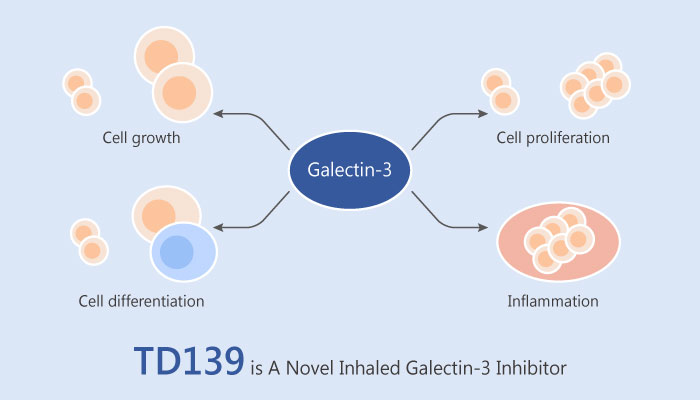Galectins are β-galactoside-binding proteins. They participate in intracellular trafficking, cell adhesion, and cell–cell signaling. They play a pivotal role in physiological and pathological activities, such as, inflammation, immune response, and bacterial and viral infections. Galectins also have drawn much attention as targets for therapeutic interventions. Additionally, Galectin-3 is highly expressed in fibrotic tissue of diverse etiologies. Knocking out galectin-3 reduces liver and kidney fibrosis after profibrotic insults. The role of galectin-3 in pulmonary fibrosis and the mechanisms by which galectin-3 affects TGF-β function and fibrosis is unknown.

TD139 is a novel high-affinity inhibitor of the galectin-3 carbohydrate binding domain (Kd = 14 nM). Besides, in primary lung AECs it reduced TGF-β1–induced β-catenin translocation to the nucleus, with most of the β-catenin remaining at the cell surface (Figure 8B). Furthermore, it blocked TGF-β1–induced β-catenin phosphorylation. TD139 displays potent inhibition of GAL-1 (Kd=10 nM) and GAL-3 (Kd=14 nM), exhibiting high selectivity for GAL-1 and -3. This inhibitor also has completed Phase Ib/IIa clinical trials for the treatment of Idiopathic Pulmonary Fibrosis.
TD139, blocked TGF-β–induced β-catenin activation in vitro and in vivo and attenuated the late-stage progression of lung fibrosis after bleomycin. Moreover, patients with stable IPF had elevated levels of galectin-3 in the BAL fluid and serum compared with patients with NSIP and control subjects, and this rose sharply during an acute exacerbation suggesting that galectin-3 may be a marker of active fibrosis in IPF. Treatment with gal3 inhibitor TD139, a derivative of thiodigalactoside, augmented human neutrophil ROS production and reduced fungal burden in mice with systemic candidiasis.